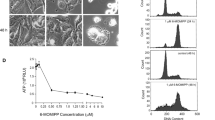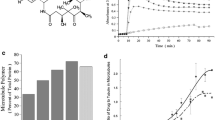Abstract
The purpose of this study was to investigate the potential effects of epothilones (EPOs), a new class of microtubule stabilizing cytotoxic drugs, on glioma cells in vitro. The effects of 1, 10 and 100 nM concentrations of EPO D in four malignant human glioma cell lines were measured using a microtiter-tetrazolium assay. Besides the cell lines U87MG, U138MG and LN405, one cell line was used, which had been derived from a recurrent and therapy-resistant glioblastoma in our laboratory. In addition, changes of the cell morphology were followed by light microscopy and changes in the microtubule and actin cytoskeleton were visualized by a confocal laser microscope. In all four human glioma cell lines, 10 and 100 nM concentrations of the drug, applied for 96 h, lead to a highly significant decrease in the viable cell number (p > 0.001). A mean reduction of the viable cell number between 30% and 40% (60% and 90%) was observed for a drug concentration of 10 nM (100 nM). A round cell morphology occured in most EPO treated cells and the organized network of microtubules was shrunk in these round cells. The tubulin immunostaining now appeared amorphous and was restricted to small perinuclear regions. Large actin filaments also disappeared, but actin staining was present in the whole cytosplasm. These results prove that EPOs have antiproliferative effects in glioma cells and affect their tubulin cytoskeleton, as it was previously observed in several types of carcinoma cells.
Similar content being viewed by others
References
Diaz JF, Menendez M, Andreu JM: Thermodynamics of ligand-induced assembly of tubulin. Biochemistry 32: 10067–10077, 1993
Bollag DM, McQuenney PA, Zhu J, Hensen O, Koupal L, Liesch J, Goetz M, Lazarides E, Woods CM: Epothilones, a new class of microtubule-stabilizing agents with a taxol-like mechanism of action. Cancer Res 55: 2325–2333, 1995
Altmann KH, Wartmann M, O'Reilly T: Epothilones and related structures—anewclass of microtubule inhibitors with potent in vivo antitumor activity. Biochem Biophys Acta 1470: M79–M91, 2000
Blagosklonny MV, Fojo T: Molecular effects of paclitaxel: myths and reality (a critical review). Int J Cancer 8: 151–156, 1999
Wang M, Xia X, Kim Y, Hwang D, Jansen JM, Bott M, Liotta DC, Snyder JP: A unified and quantitative receptor model for the microtubule binding of paclitaxel and epothilone. Org Lett 1: 43–46, 1999
Chou TC, Zhang XG, Balog A, Su DS, Meng D, Savin K, Bertino JR, Danihefsky J: Desoxyepothilone B: an effi-cious microtubule-targeted antitumor agent with a promising in vivo profile relative to epothilone B. Proc Natl Acad Sci USA 95: 9642–9647, 1998a
Chou TC, Zhang XG, Harris CR, Kuduk SD, Balog A, Savin KA, Bertino JR, Danishefsky SJ: Desoxyepothilone B is curative against human tumor xenografts that are refractory to paclitaxel. Proc Natl Acad Sci USA 95: 15798–15802, 1998b
Chou TC, O'Connor OA, Tong WP, Guan Y, Zhang ZG, Stachel SJ, Lee C, Danishefsky SJ: The synthesis, discovery, and development of a highly promising class of microtubule stabilization agents: curative effects of desoxyepothilones B and F against human tumor xenografts in nude mice. Proc Natl Acad Sci USA 98: 9113–8118, 2001
Harris CR, Danishefsky SJ: Complex target-oriented synthesis in the drug discovery process: a case history in the dEpoB series. J Org Chem 64: 8434–8456, 1999
Lee FYF, Borzilleri R, Fairchild CR, Kim SH, Long BH, Reventos-Suarez C, Vite GD, Rose WC, Kramer RA: BMS-247550: a novel epothilone analog with a mode of action similar to paclitaxel but possessing superior antitumor efficiacy. Clin Cancer Res 7: 1429–1437, 2001
Lavelle F: Newtaxanes and epothilone derivatives in clinical trials. Bull Cancer 89: 343–350, 2002
Nikkhah G, Tonn JC, Hoffmann O, Kraemer HP, Darling JL, Schönmayr R, Schachenmayr W: The MTT-assay for chemosensitivity testing of human tumors of the central nervous system. Part I: Evaluation of test-specific variables. J Neuro-Oncol 13: 1–11, 1992
Lichtner RB, Rotgeri A, Bunte T, Buchmann B, Hoffmann J, Schwede W, Skuballa W, Klar U: Subcellular distribution of epothilones in human tumor cells. Proc Natl Acad Sci 98: 11743–11748, 2001
Muehlradt PF, Sasse F: Epothilone B stabilizes microtubuli of macrophages like taxol without showing taxollike endotoxin activity. Cancer Res 57: 3344–3346, 1997
Author information
Authors and Affiliations
Rights and permissions
About this article
Cite this article
Dietzmann, A., Kanakis, D., Kirches, E. et al. Nanomolar Concentrations of Epothilone D Inhibit the Proliferation of Glioma Cells and Severely Affect their Tubulin Cytoskeleton. J Neurooncol 65, 99–106 (2003). https://doi.org/10.1023/B:NEON.0000003679.40609.63
Issue Date:
DOI: https://doi.org/10.1023/B:NEON.0000003679.40609.63




